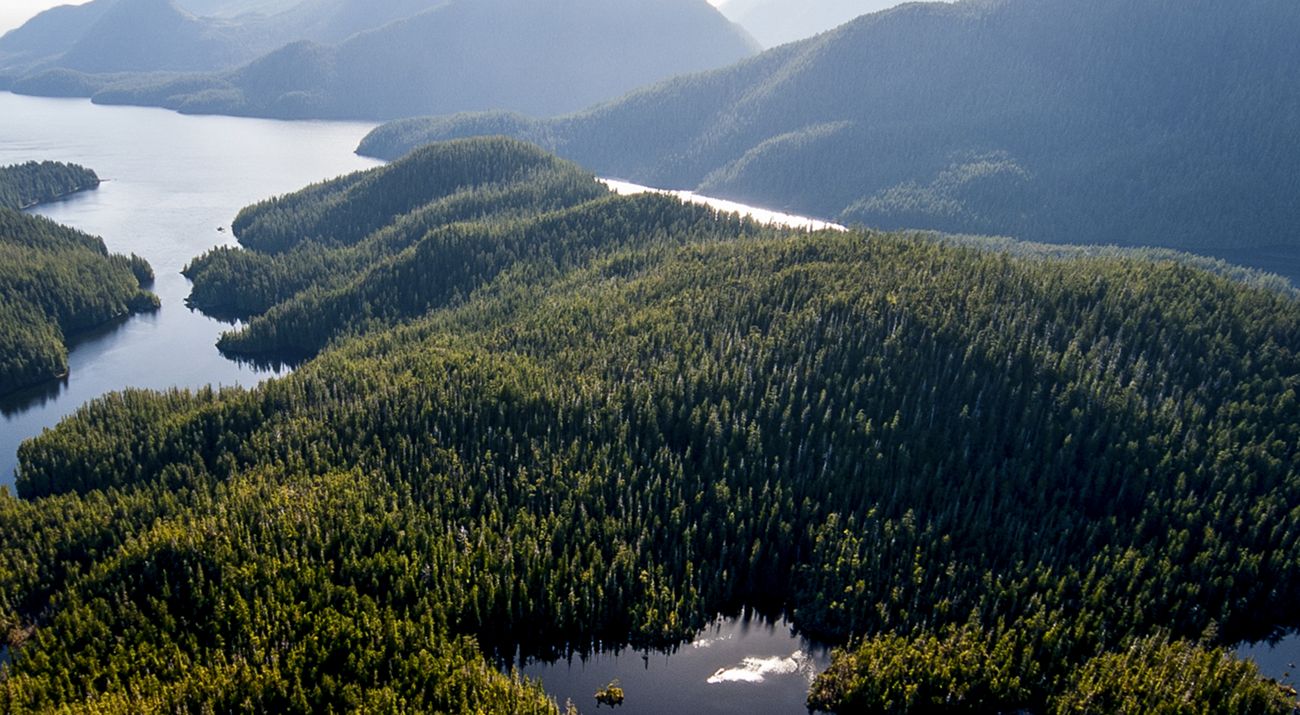
Aerial view of Clayoquot Sound
Located on the west coast of Vancouver Island in the Canadian province of British Columbia.
© Bryan Evans
Contact Us
- Phone: 206-436-6249
- Email: ashley.collings@tnc.org
-
Follow
aggregationmobilefiltertitle
By Topic
[{"title":"Rooted in Healing and Connection","description":"Reflections from the Spring 2025 Emerald Edge Network Gathering co-hosted with the Quinault Indian Nation","link":"https://www.nature.org/en-us/about-us/where-we-work/priority-landscapes/emerald-edge/emerald-edge-stories/emerald-edge-network-gathering/","target":"_self","desktopImageCrop":"center-middle","mobileImageCrop":"center-middle","pageImageAlt":"Nearly 60 participants of the 2025 EEN Gathering pose for a group photo on a sunny day at Point Haynisisoos Park.","articleDate":"Nov 10, 2025","contentTypeTag":"Feature","geoLocationTag":["British Columbia","Canada","Alaska","United States","Washington","Oregon"],"topicTag":["indigenous peoples","community conservation","conservation work","indigenous stewardship","indigenous partners","partners"],"placesWeProtectTag":[],"businesstags":["Emerald Edge","United States"],"businesstags_ids":["tnc:business-group/united-states/emerald-edge","tnc:business-group/united-states"],"pageImage":{"small":"https://natureconservancy-h.assetsadobe.com/is/image/content/dam/tnc/nature/en/photos/p/a/Particpant-group-photo-at-Haynisisoos-Park.jpg?crop=333%2C0%2C5333%2C4000&wid=300&hei=225&scl=17.77777777777778","default":"https://natureconservancy-h.assetsadobe.com/is/image/content/dam/tnc/nature/en/photos/p/a/Particpant-group-photo-at-Haynisisoos-Park.jpg?crop=333%2C0%2C5333%2C4000&wid=300&hei=225&scl=17.77777777777778","medium2x":"https://natureconservancy-h.assetsadobe.com/is/image/content/dam/tnc/nature/en/photos/p/a/Particpant-group-photo-at-Haynisisoos-Park.jpg?crop=333%2C0%2C5333%2C4000&wid=600&hei=450&scl=8.88888888888889","large":"https://natureconservancy-h.assetsadobe.com/is/image/content/dam/tnc/nature/en/photos/p/a/Particpant-group-photo-at-Haynisisoos-Park.jpg?crop=333%2C0%2C5333%2C4000&wid=300&hei=225&scl=17.77777777777778","small2x":"https://natureconservancy-h.assetsadobe.com/is/image/content/dam/tnc/nature/en/photos/p/a/Particpant-group-photo-at-Haynisisoos-Park.jpg?crop=333%2C0%2C5333%2C4000&wid=600&hei=450&scl=8.88888888888889","medium":"https://natureconservancy-h.assetsadobe.com/is/image/content/dam/tnc/nature/en/photos/p/a/Particpant-group-photo-at-Haynisisoos-Park.jpg?crop=333%2C0%2C5333%2C4000&wid=300&hei=225&scl=17.77777777777778","large2x":"https://natureconservancy-h.assetsadobe.com/is/image/content/dam/tnc/nature/en/photos/p/a/Particpant-group-photo-at-Haynisisoos-Park.jpg?crop=0%2C0%2C6000%2C4000&wid=600&hei=400&scl=10.0"}},{"title":"How Rivers Connect Us","description":"The Nature Conservancy is taking action alongside communities to support rivers in need, finding new ways to build bridges and come together wherever we work.","link":"https://www.nature.org/en-us/about-us/where-we-work/priority-landscapes/priority-landscape-stories/western-river-basins/","target":"_self","desktopImageCrop":"center-middle","mobileImageCrop":"center-middle","pageImageAlt":"A stylized graphic of people and nature enjoying a river—a man fishing, a bear feeding and a couple canoeing.","readTimeMinutes":"5","articleDate":"Sep 01, 2025","contentTypeTag":"Feature","geoLocationTag":["British Columbia","Canada","Arizona","United States","Colorado","Alaska","Oregon"],"topicTag":["rivers","water conservation","conservation work","river restoration","habitat restoration"],"placesWeProtectTag":["Sagebrush Sea","Landscapes","Colorado River"],"businesstags":["United States"],"businesstags_ids":["tnc:business-group/united-states"],"pageImage":{"small":"https://natureconservancy-h.assetsadobe.com/is/image/content/dam/tnc/nature/en/photos/w/u/WUSCANHero_2_to_1.png?crop=416%2C0%2C1666%2C1250&wid=300&hei=225&scl=5.555555555555555","default":"https://natureconservancy-h.assetsadobe.com/is/image/content/dam/tnc/nature/en/photos/w/u/WUSCANHero_2_to_1.png?crop=416%2C0%2C1666%2C1250&wid=300&hei=225&scl=5.555555555555555","medium2x":"https://natureconservancy-h.assetsadobe.com/is/image/content/dam/tnc/nature/en/photos/w/u/WUSCANHero_2_to_1.png?crop=416%2C0%2C1666%2C1250&wid=600&hei=450&scl=2.7777777777777777","large":"https://natureconservancy-h.assetsadobe.com/is/image/content/dam/tnc/nature/en/photos/w/u/WUSCANHero_2_to_1.png?crop=416%2C0%2C1666%2C1250&wid=300&hei=225&scl=5.555555555555555","small2x":"https://natureconservancy-h.assetsadobe.com/is/image/content/dam/tnc/nature/en/photos/w/u/WUSCANHero_2_to_1.png?crop=416%2C0%2C1666%2C1250&wid=600&hei=450&scl=2.7777777777777777","medium":"https://natureconservancy-h.assetsadobe.com/is/image/content/dam/tnc/nature/en/photos/w/u/WUSCANHero_2_to_1.png?crop=416%2C0%2C1666%2C1250&wid=300&hei=225&scl=5.555555555555555","large2x":"https://natureconservancy-h.assetsadobe.com/is/image/content/dam/tnc/nature/en/photos/w/u/WUSCANHero_2_to_1.png?crop=312%2C0%2C1875%2C1250&wid=600&hei=400&scl=3.125"}},{"title":"A Hoop of Many Hoops","description":"Emerald Edge Network Connects Peoples Across Colonial Borders","link":"https://www.nature.org/en-us/about-us/where-we-work/priority-landscapes/emerald-edge/emerald-edge-stories/emerald-edge-network-project-accelerator/","target":"_self","desktopImageCrop":"center-middle","mobileImageCrop":"center-middle","pageImageAlt":"People standing in a circle with arms outstretched.","articleDate":"Aug 30, 2024","contentTypeTag":"Feature","geoLocationTag":["Oregon","United States"],"topicTag":["indigenous partners","partners","conservation work"],"placesWeProtectTag":["Emerald Edge","Landscapes"],"businesstags":["Emerald Edge","United States"],"businesstags_ids":["tnc:business-group/united-states/emerald-edge","tnc:business-group/united-states"],"pageImage":{"small":"https://natureconservancy-h.assetsadobe.com/is/image/content/dam/tnc/nature/en/photos/d/s/DSC_9490.JPG?crop=57%2C0%2C885%2C664&wid=300&hei=225&scl=2.951111111111111","default":"https://natureconservancy-h.assetsadobe.com/is/image/content/dam/tnc/nature/en/photos/d/s/DSC_9490.JPG?crop=57%2C0%2C885%2C664&wid=300&hei=225&scl=2.951111111111111","medium2x":"https://natureconservancy-h.assetsadobe.com/is/image/content/dam/tnc/nature/en/photos/d/s/DSC_9490.JPG?crop=57%2C0%2C885%2C664&wid=600&hei=450&scl=1.4755555555555555","large":"https://natureconservancy-h.assetsadobe.com/is/image/content/dam/tnc/nature/en/photos/d/s/DSC_9490.JPG?crop=57%2C0%2C885%2C664&wid=300&hei=225&scl=2.951111111111111","small2x":"https://natureconservancy-h.assetsadobe.com/is/image/content/dam/tnc/nature/en/photos/d/s/DSC_9490.JPG?crop=57%2C0%2C885%2C664&wid=600&hei=450&scl=1.4755555555555555","medium":"https://natureconservancy-h.assetsadobe.com/is/image/content/dam/tnc/nature/en/photos/d/s/DSC_9490.JPG?crop=57%2C0%2C885%2C664&wid=300&hei=225&scl=2.951111111111111","large2x":"https://natureconservancy-h.assetsadobe.com/is/image/content/dam/tnc/nature/en/photos/d/s/DSC_9490.JPG?crop=2%2C0%2C996%2C664&wid=600&hei=400&scl=1.66"}},{"title":"Clayoquot Sound Agreement caps major Emerald Edge milestones supported by the Bezos Earth Fund","description":"The Ahousaht and Tla-o-qui-aht First Nations made history with an agreement with the government of British Columbia (B.C.) to protect 76,000 hectares (188,000 acres) in Clayoquot Sound.","link":"https://www.nature.org/en-us/about-us/where-we-work/priority-landscapes/emerald-edge/emerald-edge-stories/bezos-earth-fund-accomplishments-and-lessons-learned/","target":"_self","desktopImageCrop":"left-top","mobileImageCrop":"left-top","pageImageAlt":"A valley with a river and mountains.","articleDate":"Aug 22, 2024","contentTypeTag":"Feature","geoLocationTag":["Canada"],"topicTag":["indigenous peoples","community conservation","conservation work","nonprofit partners","partners","land conservation","indigenous partners"],"placesWeProtectTag":["Emerald Edge","Landscapes","Clayoquot Sound"],"businesstags":["Emerald Edge","United States"],"businesstags_ids":["tnc:business-group/united-states/emerald-edge","tnc:business-group/united-states"],"pageImage":{"small":"https://natureconservancy-h.assetsadobe.com/is/image/content/dam/tnc/nature/en/photos/7/a/7A67035F-5086-4591-8FB1-A708066054B5.jpeg?crop=0%2C0%2C3376%2C2532&wid=300&hei=225&scl=11.253333333333334","default":"https://natureconservancy-h.assetsadobe.com/is/image/content/dam/tnc/nature/en/photos/7/a/7A67035F-5086-4591-8FB1-A708066054B5.jpeg?crop=0%2C0%2C3376%2C2532&wid=300&hei=225&scl=11.253333333333334","medium2x":"https://natureconservancy-h.assetsadobe.com/is/image/content/dam/tnc/nature/en/photos/7/a/7A67035F-5086-4591-8FB1-A708066054B5.jpeg?crop=0%2C0%2C3376%2C2532&wid=600&hei=450&scl=5.626666666666667","large":"https://natureconservancy-h.assetsadobe.com/is/image/content/dam/tnc/nature/en/photos/7/a/7A67035F-5086-4591-8FB1-A708066054B5.jpeg?crop=0%2C0%2C3376%2C2532&wid=300&hei=225&scl=11.253333333333334","small2x":"https://natureconservancy-h.assetsadobe.com/is/image/content/dam/tnc/nature/en/photos/7/a/7A67035F-5086-4591-8FB1-A708066054B5.jpeg?crop=0%2C0%2C3376%2C2532&wid=600&hei=450&scl=5.626666666666667","medium":"https://natureconservancy-h.assetsadobe.com/is/image/content/dam/tnc/nature/en/photos/7/a/7A67035F-5086-4591-8FB1-A708066054B5.jpeg?crop=0%2C0%2C3376%2C2532&wid=300&hei=225&scl=11.253333333333334","large2x":"https://natureconservancy-h.assetsadobe.com/is/image/content/dam/tnc/nature/en/photos/7/a/7A67035F-5086-4591-8FB1-A708066054B5.jpeg?crop=0%2C0%2C3563%2C2375&wid=600&hei=400&scl=5.9383333333333335"}},{"title":"How First Nations' Leadership and Sustainable Finance are Creating Permanent Protection for the Great Bear Sea","description":"A historic agreement creates long-term protection for the Great Bear Sea, an ecosystem home to whales, salmon, kelp and bears off Canada's British Columbia. The deal funds First Nation stewardship.","link":"https://www.nature.org/en-us/what-we-do/our-priorities/protect-water-and-land/land-and-water-stories/protecting-great-bear-sea/","target":"_self","desktopImageCrop":"center-middle","mobileImageCrop":"center-middle","pageImageAlt":"a woman wearing a hat saying 'tlowitsis guardian watchmen' sits in a blue boat and uses metal tools to measure kelp on the water's surface, with dense forest in the background.","readTimeMinutes":"8","articleDate":"Aug 07, 2024","articleAuthor":["Adam Bloom"],"contentTypeTag":"Initiative","geoLocationTag":["British Columbia","Canada"],"topicTag":["ocean conservation","conservation work","fisheries","conservation finance","indigenous stewardship","indigenous partners","partners"],"placesWeProtectTag":[],"businesstags":["Global - All locations"],"businesstags_ids":["tnc:business-group/global-all-locations"],"pageImage":{"small":"https://natureconservancy-h.assetsadobe.com/is/image/content/dam/tnc/nature/en/photos/other/d/_DSC9474.jpg?crop=94%2C0%2C1510%2C1133&wid=300&hei=225&scl=5.035555555555556","default":"https://natureconservancy-h.assetsadobe.com/is/image/content/dam/tnc/nature/en/photos/other/d/_DSC9474.jpg?crop=94%2C0%2C1510%2C1133&wid=300&hei=225&scl=5.035555555555556","medium2x":"https://natureconservancy-h.assetsadobe.com/is/image/content/dam/tnc/nature/en/photos/other/d/_DSC9474.jpg?crop=94%2C0%2C1510%2C1133&wid=600&hei=450&scl=2.517777777777778","large":"https://natureconservancy-h.assetsadobe.com/is/image/content/dam/tnc/nature/en/photos/other/d/_DSC9474.jpg?crop=94%2C0%2C1510%2C1133&wid=300&hei=225&scl=5.035555555555556","small2x":"https://natureconservancy-h.assetsadobe.com/is/image/content/dam/tnc/nature/en/photos/other/d/_DSC9474.jpg?crop=94%2C0%2C1510%2C1133&wid=600&hei=450&scl=2.517777777777778","medium":"https://natureconservancy-h.assetsadobe.com/is/image/content/dam/tnc/nature/en/photos/other/d/_DSC9474.jpg?crop=94%2C0%2C1510%2C1133&wid=300&hei=225&scl=5.035555555555556","large2x":"https://natureconservancy-h.assetsadobe.com/is/image/content/dam/tnc/nature/en/photos/other/d/_DSC9474.jpg?crop=0%2C0%2C1699%2C1133&wid=600&hei=400&scl=2.8325"}},{"title":"How the Emerald Edge Rainforest Could Help Change the World","description":"In this remarkable forest that stretches from Oregon into Alaska, Indigenous Peoples and local communities are leading the way in showing that conservation and climate action can be done differently.","link":"https://www.nature.org/en-us/what-we-do/our-priorities/tackle-climate-change/climate-change-stories/emerald-edge-carbon-storage/","target":"_self","desktopImageCrop":"center-middle","mobileImageCrop":"center-middle","pageImageAlt":"Aerial view of waters in Clayoquot Sound on the coast of British Columbia, with forest-covered mountains in the background.","articleDate":"Oct 26, 2022","contentTypeTag":"Feature","geoLocationTag":["Canada","British Columbia","Alaska","United States","Oregon","Washington"],"topicTag":["indigenous peoples","community conservation","conservation work","carbon sequestration","carbon","climate change","indigenous stewardship","forest carbon"],"placesWeProtectTag":[],"businesstags":["Tackle Climate Change","Our Priorities"],"businesstags_ids":["tnc:business-group/our-priorities/tackle-climate-change","tnc:business-group/our-priorities"],"pageImage":{"small":"https://natureconservancy-h.assetsadobe.com/is/image/content/dam/tnc/nature/en/photos/canada/Clayoquot_Sound_Flyover.jpg?crop=412%2C0%2C976%2C732&wid=300&hei=225&scl=3.2533333333333334","default":"https://natureconservancy-h.assetsadobe.com/is/image/content/dam/tnc/nature/en/photos/canada/Clayoquot_Sound_Flyover.jpg?crop=412%2C0%2C976%2C732&wid=300&hei=225&scl=3.2533333333333334","medium2x":"https://natureconservancy-h.assetsadobe.com/is/image/content/dam/tnc/nature/en/photos/canada/Clayoquot_Sound_Flyover.jpg?crop=412%2C0%2C976%2C732&wid=600&hei=450&scl=1.6266666666666667","large":"https://natureconservancy-h.assetsadobe.com/is/image/content/dam/tnc/nature/en/photos/canada/Clayoquot_Sound_Flyover.jpg?crop=412%2C0%2C976%2C732&wid=300&hei=225&scl=3.2533333333333334","small2x":"https://natureconservancy-h.assetsadobe.com/is/image/content/dam/tnc/nature/en/photos/canada/Clayoquot_Sound_Flyover.jpg?crop=412%2C0%2C976%2C732&wid=600&hei=450&scl=1.6266666666666667","medium":"https://natureconservancy-h.assetsadobe.com/is/image/content/dam/tnc/nature/en/photos/canada/Clayoquot_Sound_Flyover.jpg?crop=412%2C0%2C976%2C732&wid=300&hei=225&scl=3.2533333333333334","large2x":"https://natureconservancy-h.assetsadobe.com/is/image/content/dam/tnc/nature/en/photos/canada/Clayoquot_Sound_Flyover.jpg?crop=351%2C0%2C1098%2C732&wid=600&hei=400&scl=1.83"}},{"title":"Photographing the Great Bear Rainforest ","description":"Photographer Jon McCormack shares why he is so inspired by nature in the Great Bear Rainforest.","link":"https://www.nature.org/en-us/about-us/where-we-work/canada/stories-in-canada/great-bear-rainforest-photography-jon-mccormack/","target":"_self","desktopImageCrop":"left-top","mobileImageCrop":"left-top","pageImageAlt":"On the beaches of the Great Bear Rainforest, grizzly bears gorge on mussels.","articleDate":"Jul 24, 2020","articleAuthor":["Jon McCormack"],"contentTypeTag":"Photo Essay","geoLocationTag":["British Columbia","Canada"],"topicTag":["wildlife watching","outdoor activities","activities","wildlife conservation","conservation work","coastal temperate","rainforests","forests","land conservation","indigenous stewardship","nature photography"],"placesWeProtectTag":[],"businesstags":["Canada"],"businesstags_ids":["tnc:business-group/canada"],"pageImage":{"small":"https://natureconservancy-h.assetsadobe.com/is/image/content/dam/tnc/nature/en/photos/canada/grizzly-beach.jpg?crop=0%2C0%2C1817%2C1363&wid=300&hei=225&scl=6.057777777777778","default":"https://natureconservancy-h.assetsadobe.com/is/image/content/dam/tnc/nature/en/photos/canada/grizzly-beach.jpg?crop=0%2C0%2C1817%2C1363&wid=300&hei=225&scl=6.057777777777778","medium2x":"https://natureconservancy-h.assetsadobe.com/is/image/content/dam/tnc/nature/en/photos/canada/grizzly-beach.jpg?crop=0%2C0%2C1817%2C1363&wid=600&hei=450&scl=3.028888888888889","large":"https://natureconservancy-h.assetsadobe.com/is/image/content/dam/tnc/nature/en/photos/canada/grizzly-beach.jpg?crop=0%2C0%2C1817%2C1363&wid=300&hei=225&scl=6.057777777777778","small2x":"https://natureconservancy-h.assetsadobe.com/is/image/content/dam/tnc/nature/en/photos/canada/grizzly-beach.jpg?crop=0%2C0%2C1817%2C1363&wid=600&hei=450&scl=3.028888888888889","medium":"https://natureconservancy-h.assetsadobe.com/is/image/content/dam/tnc/nature/en/photos/canada/grizzly-beach.jpg?crop=0%2C0%2C1817%2C1363&wid=300&hei=225&scl=6.057777777777778","large2x":"https://natureconservancy-h.assetsadobe.com/is/image/content/dam/tnc/nature/en/photos/canada/grizzly-beach.jpg?crop=0%2C0%2C2044%2C1363&wid=600&hei=400&scl=3.4075"}},{"title":"Hoonah Native Forest Partnership in the Tongass","description":"Alaska's Hoonah Native Forest Partnership is showing how cooperation leads to new possibilities on the land. ","link":"https://www.nature.org/en-us/about-us/where-we-work/united-states/alaska/stories-in-alaska/hoonah-native-forest-partnership-in-the-tongass/","target":"_self","desktopImageCrop":"center-middle","mobileImageCrop":"center-middle","pageImageAlt":"Four people wearing orange safety vests and carrying equipment walk down a dirt road in a forest.","articleDate":"Dec 24, 2019","contentTypeTag":"Feature","geoLocationTag":["Alaska","United States"],"topicTag":["indigenous peoples","community conservation","conservation work","habitat restoration","habitat restoration","forest conservation","fisheries"],"placesWeProtectTag":["Emerald Edge","Landscapes"],"businesstags":["Alaska","United States"],"businesstags_ids":["tnc:business-group/united-states/alaska","tnc:business-group/united-states"],"pageImage":{"small":"https://natureconservancy-h.assetsadobe.com/is/image/content/dam/tnc/nature/en/photos/2/8/28899315992_81ff2c9a96_o.jpg?crop=138%2C0%2C2222%2C1667&wid=300&hei=225&scl=7.408888888888889","default":"https://natureconservancy-h.assetsadobe.com/is/image/content/dam/tnc/nature/en/photos/2/8/28899315992_81ff2c9a96_o.jpg?crop=138%2C0%2C2222%2C1667&wid=300&hei=225&scl=7.408888888888889","medium2x":"https://natureconservancy-h.assetsadobe.com/is/image/content/dam/tnc/nature/en/photos/2/8/28899315992_81ff2c9a96_o.jpg?crop=138%2C0%2C2222%2C1667&wid=600&hei=450&scl=3.7044444444444444","large":"https://natureconservancy-h.assetsadobe.com/is/image/content/dam/tnc/nature/en/photos/2/8/28899315992_81ff2c9a96_o.jpg?crop=138%2C0%2C2222%2C1667&wid=300&hei=225&scl=7.408888888888889","small2x":"https://natureconservancy-h.assetsadobe.com/is/image/content/dam/tnc/nature/en/photos/2/8/28899315992_81ff2c9a96_o.jpg?crop=138%2C0%2C2222%2C1667&wid=600&hei=450&scl=3.7044444444444444","medium":"https://natureconservancy-h.assetsadobe.com/is/image/content/dam/tnc/nature/en/photos/2/8/28899315992_81ff2c9a96_o.jpg?crop=138%2C0%2C2222%2C1667&wid=300&hei=225&scl=7.408888888888889","large2x":"https://natureconservancy-h.assetsadobe.com/is/image/content/dam/tnc/nature/en/photos/2/8/28899315992_81ff2c9a96_o.jpg?crop=0%2C0%2C2500%2C1666&wid=600&hei=400&scl=4.166666666666667"}},{"title":"Sustainable Southeast Partnership","description":"A regional collective impact initiative in the mostly rural panhandle of Southeast Alaska helping to build trust, renew culture and protect nature in the Tongass National Forest.","link":"https://www.nature.org/en-us/about-us/where-we-work/united-states/alaska/stories-in-alaska/sustainable-southeast-partnership/","target":"_self","desktopImageCrop":"center-middle","mobileImageCrop":"center-middle","pageImageAlt":"Child holding red elderberry branch in front of their face.","articleDate":"Nov 12, 2019","contentTypeTag":"Initiative","geoLocationTag":["Alaska","United States"],"topicTag":["indigenous peoples","community conservation","conservation work","salmon","fish","animals","Species","economy and environment","sustainable logging","forest conservation","forests","land conservation","indigenous partners","partners"],"placesWeProtectTag":["Emerald Edge","Landscapes"],"businesstags":["Alaska","United States"],"businesstags_ids":["tnc:business-group/united-states/alaska","tnc:business-group/united-states"],"pageImage":{"small":"https://natureconservancy-h.assetsadobe.com/is/image/content/dam/tnc/nature/en/photos/a/l/Alaska-Kasaan-Elderberry-Harvest.jpg?crop=138%2C0%2C2222%2C1667&wid=300&hei=225&scl=7.408888888888889","default":"https://natureconservancy-h.assetsadobe.com/is/image/content/dam/tnc/nature/en/photos/a/l/Alaska-Kasaan-Elderberry-Harvest.jpg?crop=138%2C0%2C2222%2C1667&wid=300&hei=225&scl=7.408888888888889","medium2x":"https://natureconservancy-h.assetsadobe.com/is/image/content/dam/tnc/nature/en/photos/a/l/Alaska-Kasaan-Elderberry-Harvest.jpg?crop=138%2C0%2C2222%2C1667&wid=600&hei=450&scl=3.7044444444444444","large":"https://natureconservancy-h.assetsadobe.com/is/image/content/dam/tnc/nature/en/photos/a/l/Alaska-Kasaan-Elderberry-Harvest.jpg?crop=138%2C0%2C2222%2C1667&wid=300&hei=225&scl=7.408888888888889","small2x":"https://natureconservancy-h.assetsadobe.com/is/image/content/dam/tnc/nature/en/photos/a/l/Alaska-Kasaan-Elderberry-Harvest.jpg?crop=138%2C0%2C2222%2C1667&wid=600&hei=450&scl=3.7044444444444444","medium":"https://natureconservancy-h.assetsadobe.com/is/image/content/dam/tnc/nature/en/photos/a/l/Alaska-Kasaan-Elderberry-Harvest.jpg?crop=138%2C0%2C2222%2C1667&wid=300&hei=225&scl=7.408888888888889","large2x":"https://natureconservancy-h.assetsadobe.com/is/image/content/dam/tnc/nature/en/photos/a/l/Alaska-Kasaan-Elderberry-Harvest.jpg?crop=0%2C0%2C2500%2C1666&wid=600&hei=400&scl=4.166666666666667"}},{"title":"Economic Development in the Emerald Edge","description":"Learn why The Nature Conservancy is developing conservation strategies rooted in economic development for the Emerald Edge.","link":"https://www.nature.org/en-us/about-us/where-we-work/priority-landscapes/emerald-edge/emerald-edge-stories/economic-development-in-the-emerald-edge/","target":"_self","desktopImageCrop":"center-middle","mobileImageCrop":"center-middle","pageImageAlt":"Mayor Anthony \"Tony\" Christianson seine fishes","articleDate":"Jul 25, 2019","contentTypeTag":"Program Overview","geoLocationTag":["Canada","Washington","United States","Alaska"],"topicTag":["indigenous peoples","community conservation","conservation work","sustainable fisheries","fisheries","local communities","economics","social sciences","science","sustainable logging","forest conservation"],"placesWeProtectTag":["Clayoquot Sound","Landscapes","Emerald Edge"],"businesstags":["Emerald Edge","United States"],"businesstags_ids":["tnc:business-group/united-states/emerald-edge","tnc:business-group/united-states"],"pageImage":{"small":"https://natureconservancy-h.assetsadobe.com/is/image/content/dam/tnc/nature/en/photos/t/n/tnc_18027862.jpg?crop=222%2C0%2C3556%2C2667&wid=300&hei=225&scl=11.853333333333333","default":"https://natureconservancy-h.assetsadobe.com/is/image/content/dam/tnc/nature/en/photos/t/n/tnc_18027862.jpg?crop=222%2C0%2C3556%2C2667&wid=300&hei=225&scl=11.853333333333333","medium2x":"https://natureconservancy-h.assetsadobe.com/is/image/content/dam/tnc/nature/en/photos/t/n/tnc_18027862.jpg?crop=222%2C0%2C3556%2C2667&wid=600&hei=450&scl=5.926666666666667","large":"https://natureconservancy-h.assetsadobe.com/is/image/content/dam/tnc/nature/en/photos/t/n/tnc_18027862.jpg?crop=222%2C0%2C3556%2C2667&wid=300&hei=225&scl=11.853333333333333","small2x":"https://natureconservancy-h.assetsadobe.com/is/image/content/dam/tnc/nature/en/photos/t/n/tnc_18027862.jpg?crop=222%2C0%2C3556%2C2667&wid=600&hei=450&scl=5.926666666666667","medium":"https://natureconservancy-h.assetsadobe.com/is/image/content/dam/tnc/nature/en/photos/t/n/tnc_18027862.jpg?crop=222%2C0%2C3556%2C2667&wid=300&hei=225&scl=11.853333333333333","large2x":"https://natureconservancy-h.assetsadobe.com/is/image/content/dam/tnc/nature/en/photos/t/n/tnc_18027862.jpg?crop=0%2C0%2C4000%2C2666&wid=600&hei=400&scl=6.666666666666667"}},{"title":"Mercedes Robinson-Neasloss Interview","description":"Mercedes Robinson-Neasloss has tracked grizzly bears and explored her Nation’s lands and waters—as a young Indigenous leader supported by Nature United and now in a new IMAX film about the Great Bear Rainforest. ","link":"https://www.nature.org/en-us/about-us/where-we-work/canada/stories-in-canada/mercedes-robinson-neasloss-interview/","target":"_self","desktopImageCrop":"left-top","mobileImageCrop":"left-top","pageImageAlt":"Mercedes Robinson-Neasloss was interviewed for a film about the Great Bear Rainforest, where her people have stewarded the land and water for thousands of years.","articleDate":"Mar 01, 2019","contentTypeTag":"Interview","geoLocationTag":["British Columbia","Canada"],"topicTag":["indigenous stewardship","conservation work","SEAS","conservation education","coastal temperate","rainforests","forests","land conservation"],"placesWeProtectTag":["Great Bear Rainforest","Landscapes"],"businesstags":["Canada"],"businesstags_ids":["tnc:business-group/canada"],"pageImage":{"small":"https://natureconservancy-h.assetsadobe.com/is/image/content/dam/tnc/nature/en/photos/canada/Great-Bear-Imax-Mercedes-Interview.jpg?crop=0%2C0%2C3557%2C2668&wid=300&hei=225&scl=11.857777777777779","default":"https://natureconservancy-h.assetsadobe.com/is/image/content/dam/tnc/nature/en/photos/canada/Great-Bear-Imax-Mercedes-Interview.jpg?crop=0%2C0%2C3557%2C2668&wid=300&hei=225&scl=11.857777777777779","medium2x":"https://natureconservancy-h.assetsadobe.com/is/image/content/dam/tnc/nature/en/photos/canada/Great-Bear-Imax-Mercedes-Interview.jpg?crop=0%2C0%2C3557%2C2668&wid=600&hei=450&scl=5.928888888888889","large":"https://natureconservancy-h.assetsadobe.com/is/image/content/dam/tnc/nature/en/photos/canada/Great-Bear-Imax-Mercedes-Interview.jpg?crop=0%2C0%2C3557%2C2668&wid=300&hei=225&scl=11.857777777777779","small2x":"https://natureconservancy-h.assetsadobe.com/is/image/content/dam/tnc/nature/en/photos/canada/Great-Bear-Imax-Mercedes-Interview.jpg?crop=0%2C0%2C3557%2C2668&wid=600&hei=450&scl=5.928888888888889","medium":"https://natureconservancy-h.assetsadobe.com/is/image/content/dam/tnc/nature/en/photos/canada/Great-Bear-Imax-Mercedes-Interview.jpg?crop=0%2C0%2C3557%2C2668&wid=300&hei=225&scl=11.857777777777779","large2x":"https://natureconservancy-h.assetsadobe.com/is/image/content/dam/tnc/nature/en/photos/canada/Great-Bear-Imax-Mercedes-Interview.jpg?crop=0%2C0%2C4000%2C2666&wid=600&hei=400&scl=6.666666666666667"}},{"title":"Emerald Edge Indigenous Perspective Videos","description":"To conserve the Emerald Edge—a 100-million-acre coastal temperate rainforest across WA, BC and AK—The Nature Conservancy works directly with Indigenous and local communities to put their priorities first. Hear from some of our community partners about what it means to conserve this critical landscape.","link":"https://www.nature.org/en-us/about-us/where-we-work/priority-landscapes/emerald-edge/emerald-edge-stories/emerald-edge-indigenous-perspective-videos/","target":"_self","desktopImageCrop":"left-top","mobileImageCrop":"left-top","pageImageAlt":"Great Bear Rainforest","articleDate":"Feb 13, 2019","contentTypeTag":"Video","geoLocationTag":["Canada"],"topicTag":["economics","social sciences","science","conservation work","indigenous guardians","indigenous peoples","community conservation"],"placesWeProtectTag":["Clayoquot Sound","Landscapes","Emerald Edge"],"businesstags":["Canada"],"businesstags_ids":["tnc:business-group/canada"],"pageImage":{"small":"https://natureconservancy-h.assetsadobe.com/is/image/content/dam/tnc/nature/en/photos/tnc_12297482_Full.jpg?crop=0%2C0%2C3556%2C2667&wid=300&hei=225&scl=11.853333333333333","default":"https://natureconservancy-h.assetsadobe.com/is/image/content/dam/tnc/nature/en/photos/tnc_12297482_Full.jpg?crop=0%2C0%2C3556%2C2667&wid=300&hei=225&scl=11.853333333333333","medium2x":"https://natureconservancy-h.assetsadobe.com/is/image/content/dam/tnc/nature/en/photos/tnc_12297482_Full.jpg?crop=0%2C0%2C3556%2C2667&wid=600&hei=450&scl=5.926666666666667","large":"https://natureconservancy-h.assetsadobe.com/is/image/content/dam/tnc/nature/en/photos/tnc_12297482_Full.jpg?crop=0%2C0%2C3556%2C2667&wid=300&hei=225&scl=11.853333333333333","small2x":"https://natureconservancy-h.assetsadobe.com/is/image/content/dam/tnc/nature/en/photos/tnc_12297482_Full.jpg?crop=0%2C0%2C3556%2C2667&wid=600&hei=450&scl=5.926666666666667","medium":"https://natureconservancy-h.assetsadobe.com/is/image/content/dam/tnc/nature/en/photos/tnc_12297482_Full.jpg?crop=0%2C0%2C3556%2C2667&wid=300&hei=225&scl=11.853333333333333","large2x":"https://natureconservancy-h.assetsadobe.com/is/image/content/dam/tnc/nature/en/photos/tnc_12297482_Full.jpg?crop=0%2C0%2C4000%2C2666&wid=600&hei=400&scl=6.666666666666667"}},{"title":"Listen to Tidal Change","description":"We wanted to know more about how commercial fishermen are experiencing signs of change in the places where they live and work, so we sat down to listen.","link":"https://www.nature.org/en-us/about-us/where-we-work/united-states/alaska/stories-in-alaska/tidal-change-audio/","target":"_self","desktopImageCrop":"center-middle","mobileImageCrop":"center-middle","pageImageAlt":"Commercial fishing boats in Alaska's Bristol Bay.","articleDate":"Sep 16, 2018","contentTypeTag":"Initiative","geoLocationTag":["Alaska","United States"],"topicTag":["climate change","conservation work"],"placesWeProtectTag":["Emerald Edge","Landscapes"],"businesstags":["Alaska","United States"],"businesstags_ids":["tnc:business-group/united-states/alaska","tnc:business-group/united-states"],"pageImage":{"small":"https://natureconservancy-h.assetsadobe.com/is/image/content/dam/tnc/nature/en/photos/t/n/tnc_61926440.jpg?crop=533%2C0%2C2933%2C2200&wid=300&hei=225&scl=9.777777777777779","default":"https://natureconservancy-h.assetsadobe.com/is/image/content/dam/tnc/nature/en/photos/t/n/tnc_61926440.jpg?crop=533%2C0%2C2933%2C2200&wid=300&hei=225&scl=9.777777777777779","medium2x":"https://natureconservancy-h.assetsadobe.com/is/image/content/dam/tnc/nature/en/photos/t/n/tnc_61926440.jpg?crop=533%2C0%2C2933%2C2200&wid=600&hei=450&scl=4.888888888888889","large":"https://natureconservancy-h.assetsadobe.com/is/image/content/dam/tnc/nature/en/photos/t/n/tnc_61926440.jpg?crop=533%2C0%2C2933%2C2200&wid=300&hei=225&scl=9.777777777777779","small2x":"https://natureconservancy-h.assetsadobe.com/is/image/content/dam/tnc/nature/en/photos/t/n/tnc_61926440.jpg?crop=533%2C0%2C2933%2C2200&wid=600&hei=450&scl=4.888888888888889","medium":"https://natureconservancy-h.assetsadobe.com/is/image/content/dam/tnc/nature/en/photos/t/n/tnc_61926440.jpg?crop=533%2C0%2C2933%2C2200&wid=300&hei=225&scl=9.777777777777779","large2x":"https://natureconservancy-h.assetsadobe.com/is/image/content/dam/tnc/nature/en/photos/t/n/tnc_61926440.jpg?crop=350%2C0%2C3300%2C2200&wid=600&hei=400&scl=5.5"}},{"title":"Nature’s First Defenders","description":"Are indigenous peoples the most important stewards of our natural resources on Earth?","link":"https://www.nature.org/en-us/what-we-do/our-insights/perspectives/natures-first-defenders/","target":"_self","desktopImageCrop":"center-middle","mobileImageCrop":"center-middle","pageImageAlt":"Aerial view, Koeye River.","articleDate":"Dec 09, 2016","contentTypeTag":"Feature","geoLocationTag":["British Columbia","Canada"],"topicTag":["indigenous peoples","community conservation","conservation work","forest conservation","rainforests","forests","land conservation","local communities"],"placesWeProtectTag":["Great Bear Rainforest","Landscapes"],"businesstags":["Global Insights"],"businesstags_ids":["tnc:business-group/global-insights"],"pageImage":{"small":"https://natureconservancy-h.assetsadobe.com/is/image/content/dam/tnc/nature/en/photos/k/o/koeye_4000x2200.jpg?crop=533%2C0%2C2933%2C2200&wid=300&hei=225&scl=9.777777777777779","default":"https://natureconservancy-h.assetsadobe.com/is/image/content/dam/tnc/nature/en/photos/k/o/koeye_4000x2200.jpg?crop=533%2C0%2C2933%2C2200&wid=300&hei=225&scl=9.777777777777779","medium2x":"https://natureconservancy-h.assetsadobe.com/is/image/content/dam/tnc/nature/en/photos/k/o/koeye_4000x2200.jpg?crop=533%2C0%2C2933%2C2200&wid=600&hei=450&scl=4.888888888888889","large":"https://natureconservancy-h.assetsadobe.com/is/image/content/dam/tnc/nature/en/photos/k/o/koeye_4000x2200.jpg?crop=533%2C0%2C2933%2C2200&wid=300&hei=225&scl=9.777777777777779","small2x":"https://natureconservancy-h.assetsadobe.com/is/image/content/dam/tnc/nature/en/photos/k/o/koeye_4000x2200.jpg?crop=533%2C0%2C2933%2C2200&wid=600&hei=450&scl=4.888888888888889","medium":"https://natureconservancy-h.assetsadobe.com/is/image/content/dam/tnc/nature/en/photos/k/o/koeye_4000x2200.jpg?crop=533%2C0%2C2933%2C2200&wid=300&hei=225&scl=9.777777777777779","large2x":"https://natureconservancy-h.assetsadobe.com/is/image/content/dam/tnc/nature/en/photos/k/o/koeye_4000x2200.jpg?crop=350%2C0%2C3300%2C2200&wid=600&hei=400&scl=5.5"}}]